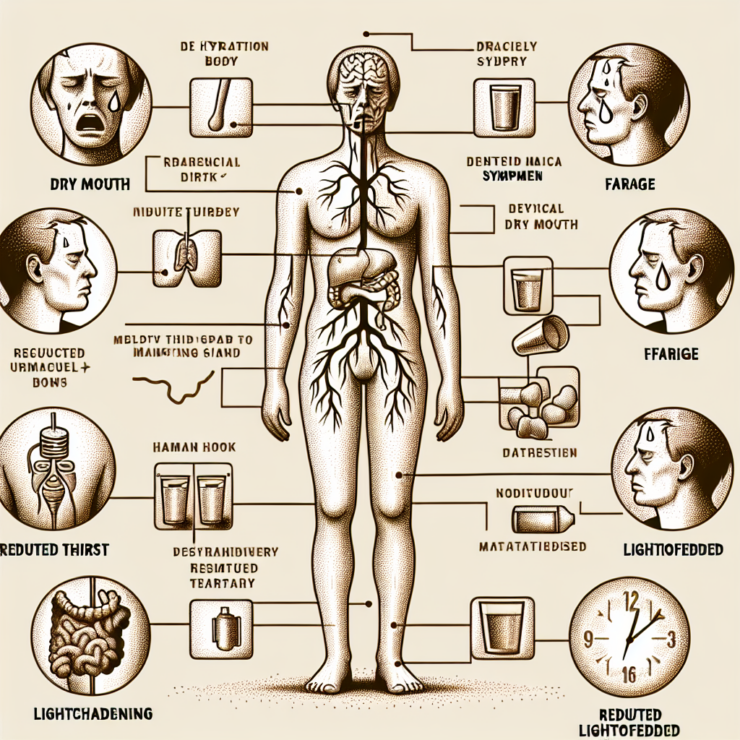The Importance of Hydration
Maintaining proper hydration is essential for overall health and well-being. The human body is composed of approximately 60% water, which plays a critical role in numerous physiological processes.
Understanding Body’s Hydration Needs
The body’s hydration needs can vary depending on several factors, including age, gender, weight, and level of physical activity. The Institute of Medicine provides general guidelines for daily water intake:
| Gender | Adequate Intake (AI) of Water (from beverages) |
|---|---|
| Men | Approximately 3.7 liters or 125 ounces |
| Women | Approximately 2.7 liters or 91 ounces |
These recommendations serve as a starting point, but individual needs may differ. For example, individuals who engage in high-intensity workouts or live in hot climates may require additional hydration to compensate for fluid loss through sweat.
The Impact of Dehydration on Health and Performance
Dehydration occurs when the body loses more fluids than it takes in, leading to an imbalance that can affect both physical and mental performance. Even mild dehydration can lead to symptoms such as fatigue, headaches, and difficulty concentrating, which can impair daily activities and work performance.
| Dehydration Level | Potential Impact |
|---|---|
| 1-2% body weight loss | Thirst, reduced endurance, elevated body temperature |
| 2-5% body weight loss | Dry mouth, decreased urine output, lethargy, weakness |
| More than 5% body weight loss | Increased heart rate, decreased blood pressure, risk of heatstroke |
Chronic dehydration can have more serious consequences, potentially contributing to kidney stones, urinary tract infections, and chronic kidney disease. Therefore, it’s crucial for busy professionals to be vigilant about their hydration status and adopt practical strategies to ensure they meet their daily fluid requirements.
Recognizing the Signs of Dehydration
The human body is composed of roughly 60% water, underscoring the critical nature of hydration for its proper functioning. Recognizing the signs of dehydration is essential for maintaining one’s well-being, especially for busy professionals who might neglect their hydration due to their demanding schedules.
Mild to Moderate Dehydration Symptoms
Mild to moderate dehydration can present with a variety of indicators. Individuals may experience symptoms such as thirst, which is the body’s natural alarm for replenishing fluids. Other common signs include:
- Dry mouth
- Fatigue or drowsiness
- Decreased urine output
- Headaches
- Dizziness
- Dry skin
- Constipation
These symptoms serve as the body’s initial warning signals suggesting that it’s time to increase fluid intake.
| Symptom | Description |
|---|---|
| Thirst | Body’s natural cue for water need |
| Dry Mouth | Lack of saliva production |
| Fatigue | Tiredness or sleepiness |
| Headaches | Pain in the head due to dehydration |
| Dizziness | A sense of unsteadiness or lightheadedness |
Severe Dehydration Symptoms
When the body loses a significant amount of fluids and they are not replenished, severe dehydration can occur. This is a more serious state that requires immediate attention. Symptoms of severe dehydration include:
- Rapid heartbeat
- Rapid breathing
- Sunken eyes
- Shriveled and dry skin
- Dark-colored urine
- Delirium or confusion
- Extreme thirst
If someone exhibits signs of severe dehydration, they should seek medical care promptly to avert more serious health consequences.
| Symptom | Description |
|---|---|
| Rapid Heartbeat | Increase in heart rate |
| Sunken Eyes | Eyes appear hollow |
| Dark Urine | Concentrated urine indicating low hydration |
Long-Term Effects of Chronic Dehydration
Chronic dehydration, when the body is frequently deprived of adequate fluids over an extended period, can lead to long-term health issues. Persistent dehydration can affect various body systems and may result in:
- Kidney stones
- Urinary tract infections
- Hypertension
- Renal failure
- Cognitive impairment
Maintaining optimal hydration is vital for organ function, physical performance, and overall health. It is especially crucial for busy professionals to recognize these signs and take proactive measures to ensure they meet their daily hydration requirements.
| Long-Term Effect | Description |
|---|---|
| Kidney Stones | Hard deposits formed in kidneys |
| Hypertension | High blood pressure |
| Renal Failure | Kidney’s inability to filter waste |
By being vigilant and responsive to the signs of dehydration, individuals can take swift action to replenish their body’s water levels, safeguarding their health and enhancing their daily performance.
Factors Contributing to Dehydration
Dehydration can occur for various reasons, many of which are related to daily habits and environmental factors. Understanding these can help busy professionals manage their hydration levels more effectively.
Busy Lifestyles and Hydration
In the hustle of professional life, staying hydrated may not seem like a priority. Meetings, deadlines, and workflows can distract individuals from listening to their body’s hydration cues. The lack of breaks can also reduce opportunities to drink water, leading to unintended neglect of fluid intake.
| Activity | Potential Hydration Impact |
|---|---|
| Long meetings | Reduced water intake |
| High workload | Ignoring thirst signals |
| Travel for work | Disruption in regular water consumption patterns |
Environmental Factors and Physical Activity
Environmental conditions such as high temperatures and low humidity can increase the body’s fluid loss through sweating. Physical activity, especially in such environments, further intensifies fluid loss, making hydration even more critical.
| Environmental Condition | Fluid Loss Increase |
|---|---|
| High temperature | Moderate to High |
| Low humidity | Moderate |
| Physical activity in hot climate | High |
Professionals who engage in occupational physical activity or who exercise amid their busy schedules should be particularly mindful of their fluid replacement needs.
Diet and Fluid Intake
Diet plays a significant role in maintaining hydration levels. Diets high in sodium or protein may require more fluid intake, as these nutrients can increase water excretion. Conversely, diets rich in fruits and vegetables can contribute to hydration due to their high water content.
| Nutrient | Impact on Hydration |
|---|---|
| Sodium | Increases fluid needs |
| Protein | Increases fluid needs |
| Fruits/Vegetables | Contributes to hydration |
Fluid intake doesn’t only have to come from water; other beverages and foods also contribute. However, caffeinated and alcoholic drinks can have a diuretic effect, potentially leading to increased fluid loss if not consumed in moderation.
By recognizing the factors contributing to dehydration, individuals can take proactive steps to ensure they meet their hydration needs. Regularly consuming water, adjusting fluid intake based on activity and environmental conditions, and choosing a balanced diet are practical strategies that can help busy professionals stay hydrated.
Practical Hydration Strategies
Implementing practical hydration strategies can ensure the body’s hydration needs are met, especially for busy professionals who may not prioritize water intake. These strategies are designed to help prevent the signs of dehydration and maintain optimal health and performance.
Identifying Individual Hydration Needs
Each person’s hydration needs can vary based on a variety of factors such as age, weight, gender, climate, and level of physical activity. A general guideline is the “8×8 rule,” which suggests eight 8-ounce glasses of water per day, but individual requirements may differ.
To determine a more personalized hydration goal, one can calculate their daily water needs using the following guideline:
| Body Weight (lbs) | Water Intake (oz) |
|---|---|
| 120 | 60 – 80 |
| 140 | 70 – 94 |
| 160 | 80 – 107 |
| 180 | 90 – 120 |
| 200 | 100 – 134 |
Note: This table provides an estimated range. Individuals should adjust their intake based on their specific lifestyle and needs.
Tips for Increasing Water Intake
To ensure adequate hydration throughout the day, consider these simple tips:
- Keep a reusable water bottle at hand, refilling it throughout the day.
- Set regular reminders on your phone or computer to take a water break.
- Flavor water with natural ingredients like cucumber, lemon, or mint for variety.
- Consume water-rich foods such as fruits and vegetables as part of your diet.
- Begin and end your day with a glass of water to establish a routine.
Hydration for Busy Professionals
Professionals with demanding schedules may find it challenging to maintain hydration. Here are some strategies tailored for the workplace:
- Start meetings with a round of water rather than coffee.
- Organize a workplace challenge to encourage colleagues to drink more water.
- Schedule short breaks specifically for hydrating.
- Opt for water over sugary drinks during lunch and networking events.
To monitor progress and ensure that hydration goals are being met, busy professionals might:
- Keep a daily log of water intake.
- Pay attention to natural thirst signals.
- Notice improvements in energy levels, focus, and overall well-being as signs of proper hydration.
Balancing the demands of a busy career with the body’s need for water is crucial for maintaining energy, productivity, and health. By adopting these practical strategies, professionals can integrate better hydration habits into their daily routines and ward off the signs of dehydration.
Monitoring Hydration Levels
Maintaining proper hydration is essential for overall health, yet it can be easily neglected by individuals with demanding schedules. Monitoring hydration levels is a proactive step towards ensuring the body gets the fluids it needs to function optimally.
Using Physical Indicators
One can assess their hydration status by paying attention to physical indicators. Signs of adequate hydration include regular urination, moist skin, and a lack of symptoms such as headaches or dizziness. It’s vital for individuals to become familiar with their body’s signals and respond accordingly.
| Indicator | Hydrated Status | Dehydrated Status |
|---|---|---|
| Skin Elasticity | Skin snaps back quickly when pinched | Skin tents or stays folded |
| Mouth and Lips | Moist | Dry or chapped |
| Eyes | Clear, not sunken | Dry or sunken |
| Thirst | Rare | Frequent or intense |
Understanding Urine Color and Volume
Urine color and volume provide valuable insights into a person’s hydration levels. Clear or light-colored urine typically indicates proper hydration, while dark yellow or amber urine can be a sign of dehydration. Adequate urine volume is also indicative of good hydration.
The following table illustrates the correlation between urine color and hydration status:
| Urine Color | Hydration Status |
|---|---|
| Clear to pale yellow | Well-hydrated |
| Light yellow | Adequately hydrated |
| Dark yellow | Mildly dehydrated |
| Amber or honey | Dehydrated |
| Dark amber or brown | Severely dehydrated |
Individuals are encouraged to regularly check their urine color as a routine part of their personal health monitoring.
The Role of Technology in Tracking Hydration
Technology has paved the way for more precise hydration tracking. Various apps and smart devices are designed to remind users to drink water throughout the day and provide feedback on their fluid intake. Some wearable devices even have the capability to monitor sweat loss and prompt rehydration.
Incorporating these technological tools can assist busy professionals in maintaining adequate hydration despite their hectic schedules. By setting reminders and tracking their intake, individuals can make informed decisions about when and how much to drink, ensuring their hydration needs are met consistently.











